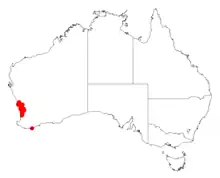| Acacia incrassata | |
|---|---|
| Scientific classification | |
| Kingdom: | Plantae |
| Clade: | Tracheophytes |
| Clade: | Angiosperms |
| Clade: | Eudicots |
| Clade: | Rosids |
| Order: | Fabales |
| Family: | Fabaceae |
| Subfamily: | Caesalpinioideae |
| Clade: | Mimosoid clade |
| Genus: | Acacia |
| Species: | A. incrassata |
| Binomial name | |
| Acacia incrassata | |
 | |
| Occurrence data from AVH | |
Acacia incrassata is a shrub belonging to the genus Acacia and the subgenus Phyllodineae that is endemic to south western Australia.
Description
The erect pungent shrub typically grows to a height of 0.1 to 0.3 metres (0.3 to 1.0 ft).[1] It is able to spread by subterranean runners. The prominently ribbed branchlets have soft silky hairs that are usually sparsely distributed and mostly found on the ribs. The branchlets also have indurate to spinose stipules that are 1.5 to 3 mm (0.059 to 0.118 in) in length. Like most species of Acacia it has phyllodes rather than true leaves. The evergreen pungent and shiny glabrous phyllodes are inequilateral often with an obtriangular to obdeltate shape and with a length of 5 to 12 mm (0.20 to 0.47 in) and a width of 4 to 10 mm (0.16 to 0.39 in)and a prominent midrib near the abaxial margin.[2] It produces yellow flowers from June to August.[1]
Distribution
It is native to an area along the west coast in the Wheatbelt and Peel regions of Western Australia where they are often situated in lateritic soils.[1] The bulk of the population is found from around Mount Lesueur in the north down to around Kalamunda in the south and also from around Serpentine and Watheroo where it is found in loamy soils in as a part of Eucalyptus wandoo woodlands or loamy gravelly soils in low heath communities.[2]
See also
References
- 1 2 3 "Acacia incrassata". FloraBase. Western Australian Government Department of Biodiversity, Conservation and Attractions.
- 1 2 "Acacia incrassata". World Wide Wattle. Western Australian Herbarium. Retrieved 20 June 2020.